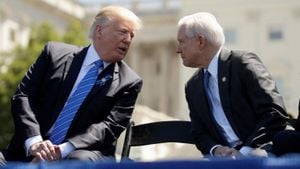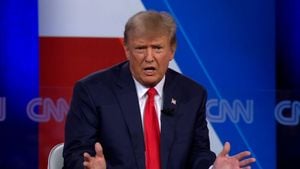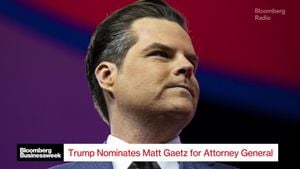Donald Trump's return to the White House has ignited considerable interest and speculation about his next steps and the policies he aims to implement during his second term. Trump's first days back are marked not only by his cabinet selections but also by the broader challenges he faces as he resumes the presidency under changed political dynamics and public expectations.
After winning the 2024 presidential election, Trump took the helm with a strong mandate, reflecting both the enthusiasm of his supporters and the concerns of undecided voters who opted for change after years of Democratic leadership. Critics were quick to note, though, the historical precedents often related to midterm outcomes and the umbilical relationship between the party power structure and economic conditions.
One significant move by Trump has been the selection of Robert F. Kennedy Junior to lead the Department of Health and Human Services (HHS). This choice sparks debates about its potential implications for health policy administration, particularly considering Kennedy's history of vocal criticisms against various health establishment practices. Supporters of this appointment argue it reflects Trump's commitment to addressing issues with fresh perspectives, differing from Biden’s approach.
Contrastingly, Trump’s critics point to Kennedy’s controversial views on vaccines and pharmaceuticals, framing the choice as indicative of Trump's willingness to carry on policies antagonistic to scientific consensus. This sentiment echoes the challenges of the Biden administration's attempts to steer public health policy amid fierce opposition and differing ideologies on health management.
From the outset of Trump's administration, the cabinet formation emphasized strategical incumbency, with figures associated with loyalty to the Trump brand over traditional party establishment credentials. This approach is not without its risks, as it questions the conventional expectations of cabinet competence and expertise rooted more evidently during Biden’s administration.
Trump's cabinet selections are coupled with broader economic concerns following his return. Experts are already analyzing the current economic environment, including inflation, job growth, and overall market stability. Despite apparent successes noted during Biden's presidency, including record low unemployment and high economic growth rates, Trump may face the task of addressing perceptions of economic distress among voters who are feeling the pinch of rising prices on staples like food and gas.
The economic backdrop serves as both challenge and opportunity for Trump. Historically, first-year presidencies influence public perception during midterms and beyond, positioning Trump's economic decisions as pivotal. With inflation and supply chain issues still at the forefront, every economic gesture from the Trump administration will be subjected to scrutiny.
Adding to the complexity, the Biden administration’s approach has emphasized regulatory oversight aimed at fostering competition and dismantling large corporate influence, which Trump will have to navigate carefully. Many observers wonder whether Trump will adopt some of the frameworks established under Biden or revert to his prior strategies of deregulation and lower corporate taxes.
While grappling with rebuilding his cabinet, Trump must also contend with re-establishing credibility with the electorate. The national discourse remains thick with concerns about his previous administration's controversial policies and their ramifications.
Trump's strategy will likely hinge on significant legislative initiatives aimed at job creation and combating inflation. Analysts suggest he may attempt to roll back parts of Biden’s legislative achievements, which had been built on infrastructure reforms and healthcare regulations aimed at stabilizing the post-COVID economy. His supporters view this as not only necessary but as betting on economic recovery looms over every economic discussion.
Some political commentators argue Trump’s return reflects dissatisfaction with the status quo and signals a renewed appetite for populist-driven policies. If he is to succeed, he may have to walk the line between radical departures from Democratic policies and the expectations of moderate voters hesitant to return to extreme partisan divides.
During this dynamic period, Trump’s messaging around his cabinet picks and early governance will influence public support. The emphasis on loyalty and outsider perspectives is risky but palpable, as lobbying from entrenched interests remains potent.
From heightened tensions abroad to infrastructure investments domestically, Trump's second term could reshape public policy. The melding of economic strategy with healthcare reform places significant pressure on his administration to deliver tangible results early on. Stakeholders both inside and outside Washington are gearing up for the heightened political activity promised by Trump’s ambitious agenda.
Challenges will abound, particularly as he seeks to establish continuity and stability amid partisan fervor. The balance of governance will not only influence Trump’s policies but also the upcoming midterm elections, which could very well dictate the overall direction of his presidency.
Yet with his legacy intertwined with bold declarations and dramatic shifts, the coming months will reveal whether Trump can bring his unique brand of leadership to meet the demands of modern America. Expectations are high and as the dust settles post-election, all eyes will be on how effectively Trump leads under scrutiny and changing dynamics.



